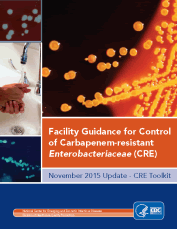Carbapenem-resistant Enterobacteriaceae in Healthcare Settings
CRE, which stands for carbapenem-resistant Enterobacteriaceae, are a family of germs that are difficult to treat because they have high levels of resistance to antibiotics. Klebsiella species and Escherichia coli (E. coli) are examples of Enterobacteriaceae, a normal part of the human gut bacteria, that can become carbapenem-resistant. Types of CRE are sometimes known as KPC (Klebsiella pneumoniae carbapenemase) and NDM (New Delhi Metallo-beta-lactamase). KPC and NDM are enzymes that break down carbapenems and make them ineffective. Both of these enzymes, as well as the enzyme VIM (Verona Integron-Mediated Metallo-β-lactamase) have also been reported in Pseudomonas.
Healthy people usually do not get CRE infections – they usually happen to patients in hospitals, nursing homes, and other healthcare settings. Patients whose care requires devices like ventilators (breathing machines), urinary (bladder) catheters, or intravenous (vein) catheters, and patients who are taking long courses of certain antibiotics are most at risk for CRE infections.
Some CRE bacteria have become resistant to most available antibiotics. Infections with these germs are very difficult to treat, and can be deadly—one report cites they can contribute to death in up to 50% of patients who become infected.
- Interim Duodenoscope Surveillance Protocol
- Interim Duodenoscope Sampling Method
- Interim Duodenoscope Culture Method
- FAQs on the Interim Duodenoscope Surveillance Protocol
Detect and Protect – CDC is funding some states who are testing the use of “Detect and Protect” strategies to find germs causing healthcare-associated infections (HAI) and prevent their spread. Detect and Protect strategies include:
- Tracking CRE, including use of the National Healthcare Safety Network (NHSN), and
- Prevention activities, such as those found in CDC guidelines and HAI prevention toolkits.
The CRE Prevention Toolkit lists Detect and Protect strategies for healthcare facilities.
- Page last reviewed: February 23, 2015
- Page last updated: March 1, 2016
- Content source:


 ShareCompartir
ShareCompartir




